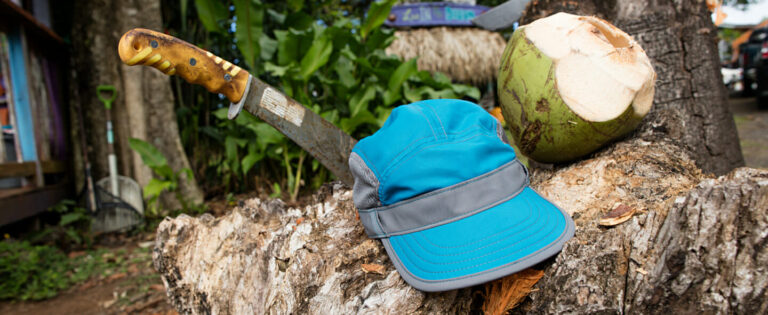
Walking, walking and more walking! What could be better than that? All you do is sleep, walk, eat, walk, sleep…and, yep, you guessed it – walk! Sunrise and sunset determine your daily rhythm. Your rucksack only seems unbearably heavy in the beginning. And, as you walk you forget about your mobile, the internet and the crowded city streets, as it all drifts further and further away. Finally some peace and quiet! Wait, what’s that? Damn, I’ve got a blister on my foot! Great, now I’m limping! Blimey, my trousers are chafing! This is going to be awful by day two! To prevent your trekking trip becoming a nightmare like the one illustrated here, it’s absolutely essential that you have the right kit.
Backpack, shoes, clothing – everything should fit well and do their job properly! This is especially true when it comes to walking trousers. After all, you won’t want (or be able) to lug around a large selection of trousers on a multi-day trip.
The cool all-rounder for long treks
But what makes up a pair of walking trousers, anyway? Why not just go for soft shells? Soft shells may seem to be taking over market, but let’s be honest: our beloved walking trousers still have a lot going for them, especially on multi-day trips. For example, when it rains, your walking trousers can be worn underneath your waterproof trousers and will be well protected. Softshell trousers, however, are usually not capable of withstanding a downpour. A lighter pair of walking trousers, on the other hand, provides more breathability in fair conditions and have a lighter feel to them. And: A lot of models can be converted into a pair of shorts, which eliminates the need for two garments, automatically saving room in your pack. The more casual-looking walking trousers can also be considered to be all-purpose trousers – ones you could wear through a city, if need be.
Another small, but significant difference between the two kinds of trousers: Walking trousers usually have more pockets! The large thigh pockets are particularly convenient, as they give you a place to keep your map, so you won’t have to fumble around for it in your pack every single time you want to check your location.
What’s more, despite their small pack size and lightweight feel, most walking trousers protect you from the sun and insects as well, both of which will come in really handy on long treks.
A general overview of available products

As was already mentioned, fit and pack size are extremely important factors when it comes to trekking. For comfort, walking trousers usually come equipped with articulated knees like the FJÄLLRÄVEN – Barents Pro walking trousers. Plus, most trousers are stretchy, allowing for a wide range of motion.
As for the fabric, walking trousers are made of different materials, and it all really comes down to your own personal preference. Because of odour and those annoying swooshing noises, some walkers swear by a blend of cotton and synthetics, as in the Abisko Trousers from Fjällräven or by merino wool and synthetics, as in the Pelmo Pants walking trousers from Ortovox , whilst others prefer purely synthetic trousers. However, all high-quality walking trousers usually have a solid level of breathability and wind and/or water-repellent properties. When it comes to choosing material, it’s always important to opt for a fabric that feels good to you.
Some more important details on walking trousers
Several walking trouser models can be adjusted to accommodate changes in weather conditions. For example, many of them have zip-off legs. It’s really convenient to have a pair of trousers that not only have detachable legs but ones with a full-length side zip, like the Women’s Jasay from Salewa. That way, you can keep your boots on when you zip off the legs. Some models, such as the Exploration Convertible Pant from The North Face are even more versatile: If you’d rather not take the entire trouser leg off, you can simply roll it up and secure it using the loops provided.
Speaking of trouser legs, some manufacturers even make different trouser lengths for those who have trouble with the standard lengths. Fjällräven, for example, solved this problem with their “raw length”, which you’ll find in models like the Karl Pro Trousers walking trousers from Fjällräven. With these, the length of the leg can be adjusted ever so precisely to meet your needs. Lundhags has developed a similar feature, which can be found in the Lundhags Jonten Pant. These have an unshortened length that can be adjusted to your leg.
Walking trousers take quite a beating

Multi-day treks can be tough, not only in terms of the distance but also when it comes to the terrain. We trekkers often traverse dense undergrowth, trudge along rock and it’s not at all rare for us to sit down for a break in the sand, either! For precisely this reason, walking trousers come equipped with reinforced panels at the knee and seat. Examples thereof can be found on the Terminal 2.0 DST walking trousers for men. This tough material serves to increase the lifespan of the trousers in areas of high wear – something that is especially important when you’re going cross country.
Special areas of use
If you already know exactly where your walking adventure is going to take you, you can start looking for a pair of trousers tailored to your specific needs. For example, if you’re heading to the tropics, it’s important to have ones made of lightweight and extremely breathable fabric that will protect you from insects. In regions ridden with scorpions and leeches (yikes), cuffs underneath the trouser legs are a great thing to have. In regions with intense sunlight or at high altitudes, you’ll need a pair of trousers that provide high UV protection. If you’ll be moving along a via ferrata, it’s important that the legs are stretchy. In other words, the trousers should allow for enough range of motion for larger movements.
If you’re planning a more treacherous journey through snow, then the kind of trousers you’re looking for will change from walking to touring or winter trousers.
Three hot tips for good measure
Tip one: Before you head out, make sure your belt or the belt loops on your trousers don’t get in the way of the hip belt on your rucksack. To avoid this problem, many brands (the ones that include belts with their trousers) use flat belts with flat buckles.
Tip two: When trying on a pair of zip-off trousers, make sure the zips don’t chafe your thighs or rub up against the backs of your knees.
Tip three: Always take good care of your zipped-off trouser legs! Otherwise, you might be a half a leg short – forever!



